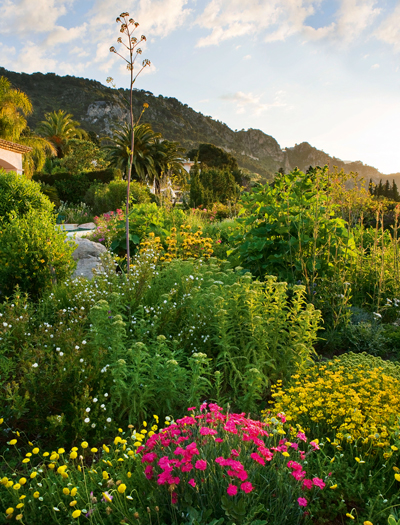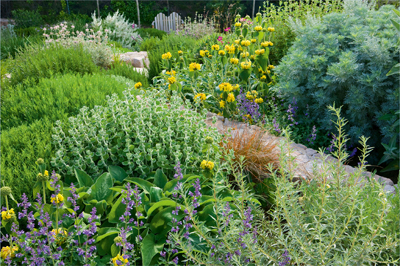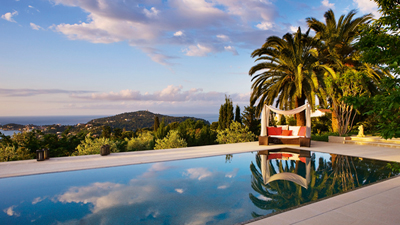Visit this garden with Country Life
Louisa Jones explores the garden of a new villa on the Côte d'Azur, where an ecological approach creates a ‘contemporary pastoral' aesthetic in tune with Nature. An exclusive tour with Country Life is running this spring.


On the French Riviera, the great English garden heritage has sometimes weighed heavily on later generations. Lawrence Johnston's Serre de la Madone is forever young, even in its advanced years, but lesser talents have often fallen into Edwardian or Italianate pastiche, still treating the South of France as a kind of colonial outpost.
But a new generation of garden designers is revealing a different approach, where ancient Mediterranean landscape models combine with new forms of cultural cross-pollination. Among them are James and Helen Basson, who strive to make gardens sympathetic to the natural environment, using mainly young plants that are compatible with the native climate and soil.
It's a refreshing approach in the now highly built-up coastline of the Riviera, where wild nature is the ultimate luxury. Coastal villas enjoy glorious sea panoramas, so surrounding them with gardens that evoke native Mediterranean landscapes is perhaps nostalgic, but it's also forward-looking, with a kind of ‘contemporary pastoral' aesthetic.

Witness a beautiful, vital example near the Moyenne Corniche above Cap Ferrat, shown in these pages. This small garden, beside a new villa on steeply sloping ground at Villefranche-sur-Mer, is just three years old and perfectly suits both the site and its owners. They are not the brilliant cosmopolitans of yesteryear arriving for the Season, but a young French family wanting a garden to live in year-round.
Low maintenance was part of the brief, but the owners have been deeply involved in the dynamics of their land. On a steep slope covering half an acre, three houses sit on slightly different levels, hidden from each other by the curve of the hill. James explains: ‘We had to find a solution that would create a unified approach to the three individual properties, but also maintain privacy for the interconnected spaces.' The main villa is beside a sleek swimming pool, which is carefully kept the same colour as the sea that's so dramatically apparent beyond.
Six graphic, multi-trunked Lagerstroemia trees soften the geometric terracing and a small lawn of warm-season, easy-care Zoysia tenuifolia grass offers cool repose at the west end. The main planting covers the terraced bit of hill below the house to the south-east, where, James says, ‘the clean-cut simplicity of the pool and crisp edging of the paving contrast with the complexity of the planting'.

** Subscribe to Country Life and save
Exquisite houses, the beauty of Nature, and how to get the most from your life, straight to your inbox.
Careful forethought combines ingeniously with spontaneous variation. Several hundred different plant types have been placed according to exposure, height and volume, to create bands of grey and green foliage accentuated by low retaining walls. The resulting rhythms are visually dynamic and evolve from season to season. In their choices, the Bassons have been influenced by the work of Olivier Filippi, who, with his wife, Clara, runs a nursery near Montpellier featuring plants selected after close observation of ecocsystems all around the Mediterranean (Country Life, January 8, 2014). The Villefranche garden thus depends on careful forethought, but is open to random incident; self-sowing is encouraged.
The initial planting was very dense, to ensure quick coverage of the soil, so where three plants of winter savory were put in, one was removed six months later. And the mix is always evolving: the silvery association of Artemisia arborescens, Ballota pseudodictamnus and Santolina chamaecyparissus Lemon Queen depends not only on a similar tone, but also on contrasting textures-different ways of catching the light. But each of these plants expands at a different speed, all of which must be taken into account. James explains: ‘We feel we were able to lay out a garden of great diversity without being too bold. When you're not too controlling, things happen that you didn't imagine to start with, which make the garden more interesting. The plants themselves make some of the decisions. It's fabulous to see the "fight" between the salvia and the iris.' And there is also pleasure in watching the hummingbird hawk moths enjoying the salvia flowers.
Even with the paths, some were planned but others happened. The layout takes into account multiple viewpoints, not least from a shady seat below. In some parts, where the plants are well mulched, it's possible to wander among them at will. The owners didn't want crunchy gravel, however, and any vegetative mulch may enrich the soil, already not quite poor enough for this kind of planting. This tapestry is really handsewn, as well as hand-sown.

The mirror-like pool and terrace, with their view of
Saint-Jean-Cap-Ferrat.
Two key plants tie the garden together: the diminutive Japanese grass Miscanthus sinensis Yaku-jima and creeping or Corsican rosemary. A big swathe of the latter rounds the corner to the next space, ‘so you get the feeling there's something happening that links the whole'. Dry-stone terracing also links the main villa and the guest house, slightly down the hill, where a simpler, even lower maintenance version of the garrigue garden has been planted. As designer-gardeners, the Bassons moderate and guide; the owners participate. As James insists: ‘This is a garden for people who love plants.' Visit www.scapedesign.com or email helen@scapedesign.com
Country Life goes to the Côte d'Azur in May
The garden featured here is one of a collection of glorious private paradises to be visited during an exclusive Country Life tour to the Côte d'Azur from May 9 to 14.
Hosted by David Wheeler and timed for the moment when the gardens of the south are erupting with roses and the fragrances are released into the warmth of longer days, highlights include the remarkable, private botanical garden of Les Cedres at Saint-Jean-Cap-Ferrat, designed a century ago by Harold Peto; the enchanting garden of Joanna Millar, a well-known Riviera gardener; Villa Boccanegra, first made famous by Ellen Willmott; and Fort France, subject of a 1930s bestseller by Winifred Fortescue and now gardened by artist Valérie de Courcel.
We also explore classic favourites of the region, including William Waterfield's Clos du Peyronnet, Lawrence Johnston's Serre de la Madone and the wondrous Hanbury gardens. Combining delicious lunches with our garden owners and some fine evening dining, this unique tour is based in two elegant and highly regarded hotels: the Napoleon, close to the sea at Menton, and Château Saint-Martin, in the aromatic pine-clad hills near Vence. Prices from £3,498 per person, including BA flights from Heathrow. For more information, please contact Boxwood Tours, Rhiw, Llanbedr, Gwynedd, LL45 2NT (01341 241717; mail@boxwoodtours.co.uk; www. boxwoodtours.com)
* Follow Country Life magazine on Twitter
Country Life is unlike any other magazine: the only glossy weekly on the newsstand and the only magazine that has been guest-edited by His Majesty The King not once, but twice. It is a celebration of modern rural life and all its diverse joys and pleasures — that was first published in Queen Victoria's Diamond Jubilee year. Our eclectic mixture of witty and informative content — from the most up-to-date property news and commentary and a coveted glimpse inside some of the UK's best houses and gardens, to gardening, the arts and interior design, written by experts in their field — still cannot be found in print or online, anywhere else.
